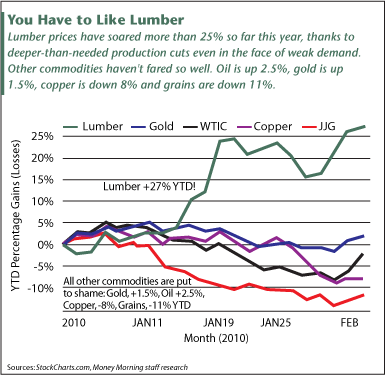Crude oil, gold, steel and commodity stocks have all taken it on the chin to varying degrees so far this year.
But not every commodity has suffered this same tough fate. In fact, there's even been a major standout. It's a commodity that most investors rarely think about.
I'm talking about lumber.
Raw lumber prices have zoomed more than 25% this year, even though the home construction business - its main use - has been scrambling along at record lows. This is a rather stunning development. But there's a solid explanation: Production has dropped in the face of weak demand - and dropped so much that prices have moved much higher (Please see chart below).

In other words, because there has been so little demand for lumber to build houses, timber companies have cut back on their harvesting and cutting. So now that home production is picking up a little - as was suggested in some earnings and economic reports last week - marginal new demand is pushing up the price of this surprisingly scarce commodity.
This is actually very good news, says Tom McClellan, a veteran technical analyst who has studied the lumber-housing relationship in great detail. He recently published a report that showed if you push a chart of the price of lumber futures one year forward, its lows tend to coincide with relative lows in the construction of new single-family homes. In essence, lows in home construction follow lows in lumber prices by 12 months.
This is important because we can now see that a major low in lumber prices was set a year ago - on Jan. 29, 2009, to be exact. With that knowledge in hand, you can extrapolate that single-family home construction is right now at a relative low.
This idea coincides with the Feb. 2 report of builder D.R. Horton Inc. (NYSE: DHI), which stated that every aspect of its business was improving in the wake of low mortgage rates, lower home prices and a federal tax credit. The revelation shocked Wall Street and sent most homebuilder stocks sharply higher for the first time in months.
The SPDR S&P Homebuilders (NYSE: XHB) Exchange-Traded Fund (ETF) has doubled from its March 2009 low, but has flat-lined since, waiting for the economics of the business to improve. Value funds are patiently buying the group with the expectation that the downside is now limited, as well as the belief that the upside could be substantial from these levels.
The ETF closed Tuesday at $15.45, and has stabilized above its 10-month moving average line. With a monthly close above $16.50 a share, the stock would be poised for a breakout. Watch out for this, but don't hold your breath - it may take awhile. Employment trends are still weak, and homebuilders have disappointed investors for four years running.
[Editor's Note: As this analysis demonstrates, Money Morning Contributing Writer Jon Markman has a unique view of both the world economy and the global financial markets. With uncertainty the watchword and volatility the norm in today's markets, low-risk/high-profit investments will be tougher than ever to find.
It will take a seasoned guide to uncover those opportunities.
Markman is that guide.
In the face of what's been the toughest market for investors since the Great Depression, it's time to sweep away the uncertainty and eradicate the worry. That's why investors subscribe to Markman's Strategic Advantage newsletter every week: He can see opportunity when other investors are blinded by worry.
Subscribe to Strategic Advantage and hire Markman to be your guide. For more information, please click here.]
News and Related Story Links:
- Money Morning:
Four Ways to Profit From a Business-Driven Rebound
- Money Morning:
Jon Markman Columns - Money Morning Special Report:
Don't Be Fooled by the Housing Market's False Bottom


